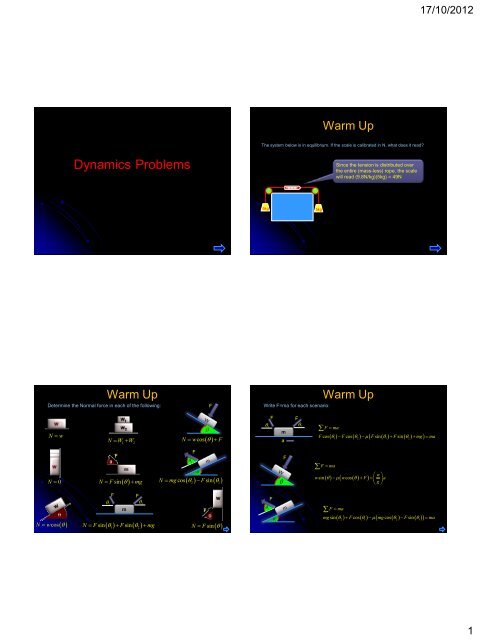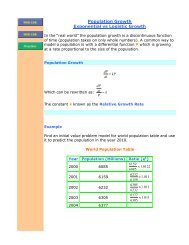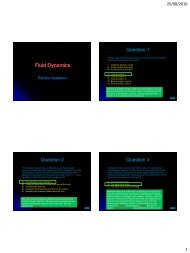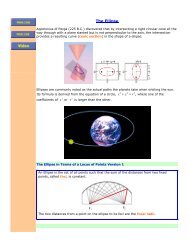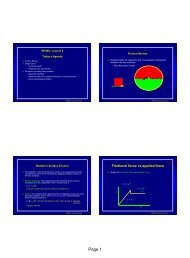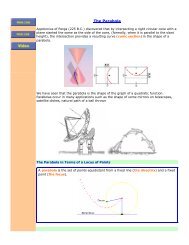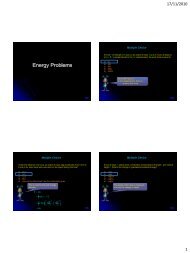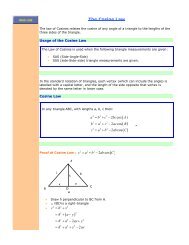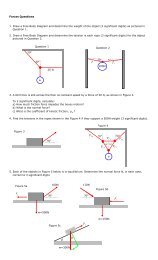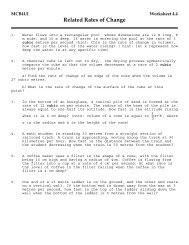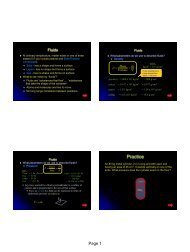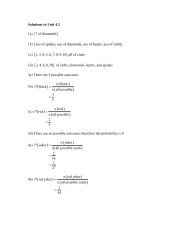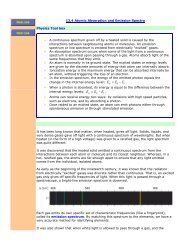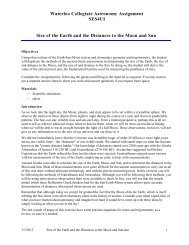Dynamics Problems - The Burns Home Page
Dynamics Problems - The Burns Home Page
Dynamics Problems - The Burns Home Page
You also want an ePaper? Increase the reach of your titles
YUMPU automatically turns print PDFs into web optimized ePapers that Google loves.
17/10/2012<strong>The</strong> system in the diagram is just on the verge of slipping. If a 7.0N weight is hangingfrom a ring, what is the coefficient of static friction between the block and the tabletop?.<strong>The</strong> weight is just in static equilibrium, so theappropriate net component forces must bezero.BlockF NRingF TcAtwood’s Machine Example:Masses m 1 = 10 kg and m 2 = 20kg are attached to an ideal massless stringand hung as shown around an ideal massless pulley.F fF GbF TbF Tb30a) What are the tensions in thestring T 1 and T 2 ?b) Find the accelerations, a 1 and a 2 ,of the masses.Fixed PulleyFrom Block:FTb Ff FffN mgFTbufmgFTb35NTbFrom ring:F F cos 30TcF F sin 30GTc7NFTcsin 30uF GCombining:7Ncos30FfTbf35Nsin 3035N 0.35FTccos3035N7Ncos30sin 3035NT 1T 2ma 11m 2 a 2• Draw free body diagrams for each object• Applying Newton’s Second Law:• T 1 - m 1 g = m 1 a 1 (a)• T 2 - m 2 g = -m 2 a 2=> -T 2 + m 2 g = +m 2 a 2 (b)But T 1 = T 2 = Tsince pulley is idealand a 1 = -a 2 =asince the masses areconnected by the string-m 1 g + T = m 1 a (a)-T + m 2 g = m 2 a (b)Free Body Diagrams• Add (b) + (a):• g(m 2 – m 1 ) = a(m 1 + m 2 )T 1 T 2( m2 m1)• a g( m1 m2)m 1 gm 2 gSolve for AccelerationTwo equations and two unknowns• we can solve for both unknowns (T and a).(20kg 10 kg) m a 9.82 (10kg 20 kg) s m 3.272sFree Body Diagramsm 1 gT 1 T 2a 1 a 2m 2 g4
17/10/2012-m 1 g + T = m 1 a (a)-T + m 2 g = m 2 a (b)Plug a into (b) and Solve for TSolve for TAtwood Machine Review ( m m )( m m )2 1T m2g m2g1 22 1T m2g m2g1mg2m1 m1\2( m m )( m m )1 2 ( m2 m1)mg2 1 ( m1m2) 2m2mm1 2 gm1m2210kg 20kg m 9.82 10kg 20kg s 130.7NFree Body DiagramsT 1 T 2a 1 a 2m 1 gm 2 g• So we find:( m2 m1)a g( m m )1 22 m1m2T =g( m + m )12aTTm 1m 2aExampleA box with mass 18.0 kg is pulled along the floor. If the horizontal force is 95.0 N [E],what is the acceleration of the box?Pulling a Box (Part 1)A box with mass 18.0 kg is pulled along the floor. If the horizontal force is 95.0 N [E],what is the acceleration of the box?Free body Diagram+y+xF NF AaF G5
17/10/2012Pulling a Box (Part 2)A two boxes, one with a mass of 4.00 kg and the other with a mass of 6.00 kg ispulled along the floor. If a horizontal force is 20.0 N [E] is applied to the 6.00 kgbox, what is the acceleration of each box, and what is the tension T at either endof the rope connecting both boxes?aF N+yF TF TF NF AExampleA two boxes, one with a mass of 4.00 kg and the other with a mass of 6.00 kg isconnected by a 1kg rope and they are pulled along the floor. If a horizontal force is20.0 N [E] is applied to the 6.00 kg box, what is the acceleration of each box, andwhat is the tension T at either end of the rope connecting both boxes?Solve for Acceleration+xNow for TensionF GF GF Aa m m1 220.0N4.00kg 6.00kgm 2.002sT m a1 N 4.00kg2.00 kg 8.00NWe could have usedthe other tensionformula from Box 2and obtained the sameanswer1.00kgPulling a Box (Part 3)A two boxes, one with a mass of 4.00 kg and the other with a mass of 6.00 kg ispulled along the floor. If a horizontal force is 20.0 N [E] is applied to the 6.00 kgbox, what is the acceleration of each box, and what is the tension T at either endof the rope connecting both boxes?Free body DiagramPulling a Box (Part 3)A two boxes, one with a mass of 4.00 kg and the other with a mass of 6.00 kg ispulled along the floor. If a horizontal force is 20.0 N [E] is applied to the 6.00 kgbox, what is the acceleration of each box, and what is the tension T at either endof the rope connecting both boxes?a+yF NF TF TF NF A1.00 kgForces+xF GF GF NF T1Because therope hasmass, thetwo ends willexperiencedifferenttensionsF T 2F NF Aa+y+x4.00 kg BoxFFxT m a111 1x m aT m a6.00 kg BoxF m ax2 xF T F A m2aT F m a2 A 2T F m a2 A 2Using F=ma for the system to find aF maAF m m m a1 2FAa m m m1 2roperopeF GF G7
17/10/2012Pulling a Box (Part 3)A two boxes, one with a mass of 4.00 kg and the other with a mass of 6.00 kg ispulled along the floor. If a horizontal force is 20.0 N [E] is applied to the 6.00 kgbox, what is the acceleration of each box, and what is the tension T in the ropeconnecting both boxes?aF NF NSolve for AccelerationFAa m m m1 220.0N4.00kg 1.00kg 6.00kgm1.822srope+yNow for T1T m a1 1+x N 4.00kg1.82 kg 7.27NF GF T2 A 2F TT F m aNow for T2F GF A N 20.0N6.00kg1.82 kg 9.09NExampleA worker drags a 38.0 kg box along the floor by pulling on a rope attached tothe box. <strong>The</strong> coefficient of friction between the floor and the box is u s =0.450and u k =0.410.a) What are the force of friction and acceleration when the worker applies ahorizontal force of 150N?b) What are the force of friction and acceleration when the worker applies ahorizontal force of 190N?38kgSolution (Free Body Diagram)a) What are the force of friction and acceleration of the worker applies ahorizontal force of 150N?F fFrictionto theleftF N38kgF G<strong>The</strong> Normal force upF T<strong>The</strong> applied force oftension to the right<strong>The</strong> force of gravitydown+y+xFF fNF NF GF mg0NNF TF y may 0FG0F mgSolution (Vector Components)What are the force of friction and acceleration of the worker applies a horizontalforce of 150N?+y N 38kg9.80 kg 372.4N+xTo determine if the box will move, we must find the maximum static friction andcompare it to the applied force.38kgFf S FN 0.450372.4N168NSince the appliedforce by the workeris only 150N, thebox will not move8
17/10/2012Solution (Vector Components)b) What are the force of friction and acceleration of the worker applies a horizontalforce of 190N?F NExampleA train of three masses is pulled along a frictionless surface. Calculate the tensions inthe ropes.F fF GF T+y+x38kgSince Fthe x ma applied x force is greater than 168N from part a), we will have anacceleration F in the x direction. So we will apply Newton’s 2 nd Law in thef F T maxhorizontal direction.F F maF K =(0.410)(372.4N)=153Nf T xFT Ffa m190N KFNm190N 0.410372.4N38kgm 0.9822s<strong>The</strong> acceleration of the boxis 0.982 m/s 2 [E]T 1 T 230 N 8 kg 5 kg 13 kgWe can find the acceleration of the train by treating the three masses as one unit.F maTTension in rope T 1 T 230N 8kg 5kg 13kg 2ama 1.15 [ left] F ma2s F maT1 T2 m2aorTTension in rope TF1T2 ma1 T2 T1 m2a m F mam 13kg 1.152 20.8N5kg1.15 s 2 FAT1 m1a s 15.1NT F m a15.1N1 A 1 m 30N8kg1.152 s 20.8NExampleA farmer uses his tractor to pull a sled loaded with firewood. Suppose the chainpulls the sled at and angle of 30 0 above the horizontal. How hard does the tractorhave to pull to keep the sled moving with a constant velocity if the sled andfirewood has a weight of 15,000 N and u k =0.40?Solution (Free Body Diagram)A farmer uses his tractor to pull a sled loaded with firewood. Supposethe chain pulls the sled at and angle of 30 0 above the horizontal. Howhard does the tractor have to pull to keep the sled moving with aconstant velocity if the sled and firewood has a weight of 15,000 Nand u k =0.40?Frictionto theleftF N<strong>The</strong> Normal force upF T<strong>The</strong> applied force oftension at 30 030 0F fF G30FTcos 30FTsin 30Tension broken down intocomponents<strong>The</strong> force of gravitydown30 09
17/10/2012Solution (Force Components)A farmer uses his tractor to pull a sled loaded with firewood. Suppose the chainpulls the sled at and angle of 30 0 above the horizontal. How hard does the tractorhave to pull to keep the sled moving with a constant velocity if the sled andfirewood has a weight of 15,000 N and u k =0.40?F NSolution (Force Components)A farmer uses his tractor to pull a sled loaded with firewood. Suppose the chainpulls the sled at and angle of 30 0 above the horizontal. How hard does the tractorhave to pull to keep the sled moving with a constant velocity if the sled andfirewood has a weight of 15,000 N and u k =0.40?F N+yF TFTsin 30+yF TFTsin 30+xF f30FTcos 3030 0+xF f30FTcos 3030 0Vertical ComponentsF y 0F GF F F 0N G TyFN mg FTsin 30 0FN mg FTsin 30Horizontal ComponentsSince we have a F x ma xconstant velocity,F f FTx0acceleration is 0kFN FTcos30 0ukmgFTsin 30 FTcos30 0We will need F N , sosolve for F NSolve for F Tuk mg FT sin 30 FTcos30 0ukmg uk FT sin 30 FTcos30 0uk FT sin 30 FT cos30 ukmgFT uk sin 30 cos30 ukmgukmgFTuksin 30 cos30F G0.4015000NFT0.40sin 30 cos 30 5628.384N 5600NExampleA group of children toboggan down a hill with a 30 0 slope. Given that thecoefficient of kinetic friction is 0.10, calculate their acceleration and the speedthey will obtain after 6.0s.Solution (Free Body Diagram)A group of children toboggan down a hill with a 30 0 slope. Given that the coefficientof kinetic friction is 0.10, calculate their acceleration and the speed they will obtainafter 6.0s.+yChoose axis orientation tomatch the direction of motionNormal isand the normal to the surfaceperpendicular tothe surface+xF fObjectF NF fF NForce of frictionopposes direction FGcos 3030of motionFGsin 30F GDecomposegravity into axiscomponentsFGFGcos 30Force of gravity isstraight downsin 3030F G10
17/10/2012Solution (Force Vectors)A group of children toboggan down a hill with a 30 0 slope. Given that thecoefficient of kinetic friction is 0.10, calculate their acceleration and the speedthey will obtain after 6.0s.F N+yF fExample 9: Solution (Force Vectors)A group of children toboggan down a hill with a 30 0 slope. Given that thecoefficient of kinetic friction is 0.10, calculate their acceleration and the speedthey will obtain after 6.0s.F N+yF fFGcos 3030+xFGcos 3030+xFGsin 30FGsin 30F GF Gy directionF y 0F N FGy0FN FGcos30 0FN FGcos30FNmgcos30x directionFx maxRemember F to solvefFGx maxfor F N because wewill needuk Fit Nlater FG sin 30 max0u mg cos 30 mg sin 30 maxk 0kcos30 sin 30a u g g xAcceleration0a u g cos 30 g sin 30xk m m 0.109.80 cos2 30 9.80 sin2 30 s s m 4.052sm 4.12sSpeedv v atfim m0 4.05 26s s sm 24.3sm 24sExampleBlock A in the diagram below weighs 1.50 N and block B weighs 4.30 N. <strong>The</strong> coefficientof kinetic friction between all surfaces is 0.20. Find the magnitude of the horizontal force,F, necessary to drag block B to the left at a constant speed if A and B are connected by alight, flexible cord passing around a fixed, frictionless pulley.Solution (Free Body Diagram)Block A in the diagram below weighs 1.50 N and block B weighs 4.30 N. <strong>The</strong> coefficientof kinetic friction between all surfaces is 0.20. Find the magnitude of the horizontal force,F, necessary to drag block B to the left at a constant speed if A and B are connected by alight, flexible cord passing around a fixed, frictionless pulley.Box Ba+y+xF Normal ForceNFriction from Friction fromObject B A TableF NF AApplied ForceF f ( box A)F f table( )Force of Gravityfrom F T A and BTensionF AF GF f ( box A)F f ( table)F TF G11
17/10/2012Solution (Free Body Diagram)Solution (Force Vectors)Block A in the diagram below weighs 1.50 N and block B weighs 4.30 N. <strong>The</strong> coefficientof kinetic friction between all surfaces is 0.20. Find the magnitude of the horizontal force,F, necessary to drag block B to the left at a constant speed if A and B are connected by alight, flexible cord passing around a fixed, frictionless pulley.Box ANormal Force+y+xaF AF NF f ( box A)F f ( table)F TBlock A in the diagram below weighs 1.50 N and block B weighs 4.30 N. <strong>The</strong> coefficient of kinetic friction between all surfaces is0.20. Find the magnitude of the horizontal force, F, necessary to drag block B to the left at a constant speed if A and B areconnected by a light, flexible cord passing around a fixed, frictionless pulley.AF NF NF fF T+y+xaBF f ( box A)F f ( table)F AF TF NF G AFrictionF f+y+xF NF G AaObjectF TTensionForce of Gravityfrom A onlyF fF G AF TF Gx-direction for Box A x-direction for Box BF0FfFT0 F F0f F F0 mg F0xTk N Tk A TFmgT k AF0F F F F 0 ( ) ( )f box A f table TA F A k F N k F N FT0( A ) ( )table F A k m A g k m A m B g FT0F A k m A g k m A mB gFTxF GFA kmAg k mA mB g kmAg3m g u m gk A k BThis was determinedusing Box ASolution (Force Vectors)Block A in the diagram below weighs 1.50 N and block B weighs 4.30 N. <strong>The</strong> coefficient of kinetic friction between all surfaces is0.20. Find the magnitude of the horizontal force, F, necessary to drag block B to the left at a constant speed if A and B areconnected by a light, flexible cord passing around a fixed, frictionless pulley.AF NF NF fF T+y+xaBF f ( box A)F f ( table)F AF TExampleHow much force is needed to give the blocks an acceleration of 3.0 m/s 2 if the coefficientof kinetic friction between the blocks and the floor is 0.20 ? How much force does the1.50 kg block exert on the 2.0 kg block?F G AF GF 3m g u m gA k A k B N N3 0.20 1.50 0.20 4.301.76N1.5kg2.0kg1.0kg12
17/10/2012Example (free body diagram)How much force is needed to give the blocks an acceleration of 3.0 m/s 2 if the coefficientof kinetic friction between the blocks and the floor is 0.20 ? How much force does the1.50 kg block exert on the 2.0 kg block?3 Blocks taken as a Single UnitNormal ForceExample (force vectors)How much force is needed to give the blocks an acceleration of 3.0 m/s 2 if the coefficientof kinetic friction between the blocks and the floor is 0.20 ? How much force does the1.50 kg block exert on the 2.0 kg block?F fF NF Aa+y+x1.5kg2.0kg1.0kgFrictionF f+y+xF NF GaObjectAppliedF AForce of Gravity1.5kg2.0kg1.0kgffxAAk N AF maF F maF F maF F mamg F maAAxF GF ma mg m N 1.5kg 2.0kg 1.0kg 3.0 2 0.201.5kg 2.0kg 1.0kg9.8 s kg 22.32N 22NExample (free body diagram)How much force is needed to give the blocks an acceleration of 3.0 m/s 2 if the coefficientof kinetic friction between the blocks and the floor is 0.20 ? How much force does the1.50 kg block exert on the 2.0 kg block?2.0 kg Block and 1.0 kg taken as a Single UnitNormal ForceSince we are considering 2.0kg and 1.0kgblock as a unit, then the Force is the pushof 1.5 kg block on the combined blockExample (force vectors)How much force is needed to give the blocks an acceleration of 3.0 m/s 2 if the coefficientof kinetic friction between the blocks and the floor is 0.20 ? How much force does the1.50 kg block exert on the 2.0 kg block?F fF NF block1+ya+x2.0kg1.0kgFriction+yF f+xF NObjectF AAppliedForce of GravityF G 2.01.0a1.5kg2.0kg1.0kgF G 2.01.0F f F block1maNF x ma xuF F mablock1umg F mablock1F ma mgblock1 m N 2.0kg 1.0kg 3.0 2 0.202.0kg 1.0kg9.8 s kg 14.88N15N13
17/10/2012A 5.00 kg object placed on a frictionless, horizontal table is connected to a string that passesover a pulley and then is fastened to a hanging 9.00 kg object.a) Find the acceleration of the two objectsb) Find the tension in the string.ExampleA 5.00 kg object placed on a frictionless, horizontal table is connected to a string that passesover a pulley and then is fastened to a hanging 9.00 kg object.a) Find the acceleration of the two objectsExample (Solution)Step 1: Free body Diagramm 1F TF TF TF T+m 1++F G =9 kg<strong>The</strong> easiest way to choose the signs for the forces is to logical choosewhat you believe will be correct direction and follow that direction fromone object to the other. If your final answer is negative, it just meansyour initial direction choice was wrong.HorizontalF m aT1F m a1+ F G =9 kgVerticalTF m aF F m aG22FT m1aF Adding these equations willT FG m2aremove the force of tension,thus Fgiving Gm1allowing a m2aus tosolve for acceleration. m 9kg 9.8m2 1 m2a s Since the answer88.2N 14kgais positive ourinitial directionma 6.3choice was correct.2s A 5.00 kg object placed on a frictionless, horizontal table is connected to a string that passesover a pulley and then is fastened to a hanging 9.00 kg object.b) Find the tension in the string.m 1F TExample (Solution)F TExampleBlocks A, B, and C are placed as in the figure and connected by ropes of negligiblemass. Both A and B weigh 25 N each, and the coefficient of kinetic friction between theblocks and the surface is 0.35. Block C descends with constant velocity.a) Determine the tension in the rope connecting Block A and B.b) What is the weight of Block C?c) If the rope connecting A and B were cut, what would be the acceleration of C?+HorizontalF m aT1F m a1+ F G =9 kgVerticalTF m aF F m aG22We need only substitute theacceleration value into eitherthe horizontal or verticalFequation.T m1a m 5kg6.32 s 31.5N14
17/10/2012ExampleBlocks A, B, and C are placed as in the figure and connected by ropes of negligible e mass. Both A and B weigh 25 Neach, and the coefficient of kinetic friction between the blocks and the surface is 0.35. Block c descends with constantvelocity.a) Determine the tension in the rope connecting Block A and B.b) What is the weight of Block C?c) If the rope connecting A and B were cut, what would be the acceleration of C?Example (Force Vectors)Blocks A, B, and C are placed as in the figure and connected by ropes of negligible e mass. Both A and B weigh 25 Neach, and the coefficient of kinetic friction between the blocks and the surface is 0.35. Block c descends with constantvelocity.a) Determine the tension in the rope connecting Block A and B.b) What is the weight of Block C?c) If the rope connecting A and B were cut, what would be the acceleration of C?F NF NF T( C)NormalF fFrictionBlock AF NF GF fObjectF TGravityF NF GTensionF NF TfF T( A)NormalFrictionTension from AF NF fF T( A)F GBlock BF GF T( C)36.9F T( C)Tension from CObjectGravityF fFFF Gf ( A) T ( A)F 00kFN F 0T AkmAg F 0T AxF TF fF T( A)F Gmg B36.9mg Bcos 36.9Block A Block B Block C F x 0F TC mCgF f B F T A F F T C 0Gxsin 36.9kF F mBg sin 36.9 F 0N B T A T CkmB cos36.9 g F mBg sin 36.9 F 0T AT CExample (Force Vectors)Blocks A, B, and C are placed as in the figure and connected by ropes of negligible e mass. Both A and B weigh 25 Neach, and the coefficient of kinetic friction between the blocks and the surface is 0.35. Block c descends with constantvelocity.a) Determine the tension in the rope connecting Block A and B.b) What is the weight of Block C?c) If the rope connecting A and B were cut, what would be the acceleration of C?Example (Force Vectors)Blocks A, B, and C are placed as in the figure and connected by ropes of negligible e mass. Both A and B weigh 25 Neach, and the coefficient of kinetic friction between the blocks and the surface is 0.35. Block c descends with constantvelocity.a) Determine the tension in the rope connecting Block A and B.b) What is the weight of Block C?c) If the rope connecting A and B were cut, what would be the acceleration of C?F NF NF T( C)F NF NF T( C)F fF TF fF T( A)mg B36.9mg Bcos 36.9sin 36.9F fF TF fF T( A)mg B36.9mg Bcos 36.9sin 36.9F GF GBlock A Block B Block CkmAg F 0T AkmB cos 36.9 g F mBg sin 36.9 F 0 FT AT CTC mgCF kmAgT AkmB cos 36.9 g F mBg sin 36.9 m 0T ACg 0.3525N mC g kmB cos36.9 g F mBgsin 36.9T A 8.75NSolving 0.35for 25theN cos36.9 8.75 Applying N 25NBlocksin 36.9 8.8Ntension between 30.757NC’s equation toblock A and B<strong>The</strong> weightBlock B 31Nof Block Ca) F 8.8NT Ab) mCg 31Nmc) a1.52sF GF GWhen the rope is cut:mC g Ff B F ma mBg sin 36.9 mB mCa mCg F m g sin 36.9 a B BmB mCf30.7N 0.3525N cos 36.9 25Nsin 36.92.55kg 3.14kgm1.532s15
17/10/2012ExampleA small rubber stopper is hung from the rear view mirror in a truck. <strong>The</strong> cord makes anangle of 9.2 0 with the vertical as the truck is accelerating forward. Determine themagnitude of the acceleration.Example (Free Body Diagram)A small rubber stopper is hung from the rear view mirror in a truck. <strong>The</strong> cord makes anangle of 9.2 0 with the vertical as the truck is accelerating forward. Determine themagnitude of the acceleration.We will look at this from outside the truck (ie the ground) because we wouldprefer an inertial frame of reference.Tensionbroken intocomponentsFTsin 9.2FT9.2FTcos 9.2TensionObjectF T9.29.2GravityF GF GExample (Force Vectors)A small rubber stopper is hung from the rear view mirror in a truck. <strong>The</strong> cord makes anangle of 9.2 0 with the vertical as the truck is accelerating forward. Determine themagnitude of the acceleration.FTsin 9.2F TExampleCalculate the acceleration of a box that experiences a magnetic force of repulsion of 12Nfrom a wall and a coefficient of friction of 0.40 between the wall and the box. <strong>The</strong> box isalso being pushed against the wall with a force of 25N at 30 0 to the horizontal.FTcos 9.29.2Vertical ForcesF y 0FGFTy0mg FTcos9.2 0mgFTcos9.2F GHorizontal Forces Fx maxax gtan 9.2FTsin 9.2max m FTsin 9.29.8 2 tan 9.2ax s mmmgsin 9.21.62scos9.2mg sin 9.2cos9.25.0 kg25N3016
17/10/2012Example (Free Body Diagram)Calculate the acceleration of an box that experiences a magnetic force of repulsion of12N from a wall and a coefficient of friction of 0.40 between the wall and the box. <strong>The</strong> boxis also being pushed against the wall with a force of 25N at 30 0 to the horizontal.25sin 3025cos 30AppliedFrictionObjectGravityMagneticNormalSince the gravity forcedown (5x9.8) is greaterthan force up (25sin(30),the box slides down, sofriction is up.5.0 kg25N30Example (Vector Forces)Calculate the acceleration of an box that experiences a magnetic force of repulsion of12N from a wall and a coefficient of friction of 0.40 between the wall and the box. <strong>The</strong> boxis also being pushed against the wall with a force of 25N at 30 0 to the horizontal.25sin 30HorizontalF x 025cos 30F F F 0Ax M NF F F 0Ax M NFN FAx FMFN 25N cos30 FMaVerticalF y ma yF F F maAy f G yF F F maAy f G y+y+x5.0 kg25N30FAy Ff FGaym25Nsin 30 kFN mgm25Nsin 30 k25Ncos30 FM mgmExample (Insert Numbers)Calculate the acceleration of an box that experiences a magnetic force of repulsion of12N from a wall and a coefficient of friction of 0.40 between the wall and the box. <strong>The</strong> boxis also being pushed against the wall with a force of 25N at 30 0 to the horizontal.25sin 3025cos 30a+y+x5.0 kg25NExampleThree hundred identical objects are connected in series on a ramp. Calculate the forcebetween objects 120 and 121 if each object has a mass of 0.50 kg and the applied forcethat is pulling them has a magnitude of 300N. <strong>The</strong> objects are accelerating at 0.88 m/s 2 ,and the coefficient of kinetic friction is 0.15.3025N sin 30 k25N cos30 FM mgaym m 25N sin 30 0.425N cos3012N 5kg9.82 s 5.0kgm 6.52s17
17/10/2012Example (Free Body Diagram)Three hundred identical objects are connected in series on a ramp. Calculate the forcebetween objects 120 and 121 if each object has a mass of 0.50 kg and the applied forcethat is pulling them has a magnitude of 300N. <strong>The</strong> objects are accelerating at 0.88 m/s 2 ,and the coefficient of kinetic friction is 0.15.Treat objects 300 thru121 as a single massFor Masses 121 to 300of 180*0.5kgNormalExample (Vector Forces)Three hundred identical objects are connected in series on a ramp. Calculate the forcebetween objects 120 and 121 if each object has a mass of 0.50 kg and the applied forcethat is pulling them has a magnitude of 300N. <strong>The</strong> objects are accelerating at 0.88 m/s 2 ,and the coefficient of kinetic friction is 0.15.For Combined Masses 121 to 300a+y +xF NF f10F T ( above)mg cos 10F NF fFrictionBig MassF T ( above)Tensionmg cos 10from above10Gravitymg sin 10F Gy-axisFNF y 0FGy0FNFGy0FN mg cos10 0FNmgcos10mg sin 10F Gx-axisF x ma xF F F maf Gx T xFf FGx FT maFN mg sin 10 FT maFT ma FN mg sin 10FT ma mg cos10 mg sin 10Example (Insert Values)Three hundred identical objects are connected in series on a ramp. Calculate the forcebetween objects 120 and 121 if each object has a mass of 0.50 kg and the applied forcethat is pulling them has a magnitude of 300N. <strong>The</strong> objects are accelerating at 0.88 m/s 2 ,and the coefficient of kinetic friction is 0.15.For Combined Masses 1 to 120a+y +xFT ma mg cos 10 mg sin 10F NF f10F GF T ( above)mg cos 10mg sin 10 m m m 180 0.5kg 0.88 2 0.15180 0.5kg 9.8 cos2 10 180 0.5kg9.8 sin2 10 s s s 362.6477N 360NExampleA person exerts a force of 175N at W30 0 S on a 20.0 kg crate which slides to the leftacross a level floor when u=0.400,a) Find the normal force on the crateb) Find the force of friction on the cratec) Find the acceleration of the crate.a30 018
17/10/2012Example (Free Body Diagram)A person exerts a force of 175N at W30 0 S on a 20.0 kg crate which slides to the leftacross a level floor when u=0.400,a) Find the normal force on the crateb) Find the force of friction on the cratec) Find the acceleration of the crate.F Na30 0Example (Vector Forces)A person exerts a force of 175N at W30 0 S on a 20.0 kg crate which slides to the leftacross a level floor when u=0.400,+yF Na) Find the normal force on the crateb) Find the force of friction on the cratec) Find the acceleration of the crate.+xy-axisaF a30 0F fF y 0Insert ValuesF gF gF fF a30 0 +y+xF F F 0N Gy AyFN FGy FAy 0FN mg FAsin 30 0FN mg FAsin 30 m FN 20.0kg 9.8 2 175Nsin30 s 196N87.5N 283.5N284NExample (Vector Forces)A person exerts a force of 175N at W30 0 S on a 20.0 kg crate which slides to the leftacross a level floor when u=0.400,Fa) Find the normal force on the crate+yNb) Find the force of friction on the cratec) Find the acceleration of the crate.+xFF fF fFfFriction Ff k N 0.400 283.5N113.4N113NaF a30 0F gF fExample (Vector Forces)A person exerts a force of 175N at W30 0 S on a 20.0 kg crate which slides to the leftacross a level floor when u=0.400,Fa) Find the normal force on the crate+yNb) Find the force of friction on the cratec) Find the acceleration of the crate.+xAccelerationF x maF F maf Ax xF F cos 30 maf A x113.4N 175N cos 30 maxmax38.1544NxaF a30 038.1554Nax20.0kgmax1.90772smax1.912WsF gF f19
17/10/2012ExampleCalculate the unknowns for each accelerated block.Example (Solution)Calculate the unknowns for each accelerated block.a)3.7 m s 2b) ac)5.6 m s 2a)3.7 m s 2AF maF F maF ma FAAfF ma Ff18 kg 0.2 m N FA18kg 3.7 2 0.218kg9.8 s kg FA102NNF 6 kg 40N 0.241Nm 0.3AF maF F maF ma FAAfF ma Ff18 kg 0.2 m N FA18kg 3.7 2 0.218kg9.8 s kg FA102NNFExample (Solution)Calculate the unknowns for each accelerated block.Example (Solution)Calculate the unknowns for each accelerated block.b) ac)5.6 m s 2AF maF F maf6 kg 40N 0.2FA Ffa mFA FNa m N 40N 0.26kg9.8kga 6kga 4.7 m 2s41N m 0.3 F maFAmg mama g FAFm Aa g41Nm m m5.620.3 9.82 s s m 4.8kg20
17/10/2012ExampleDetermine the acceleration of the cart that is required to prevent Sir Isaac Newtantfrom falling. <strong>The</strong> coefficient of static friction between the block and Newtant is μ sExampleDetermine the acceleration of the cart that is required to prevent Sir Isaac Newtantfrom falling. <strong>The</strong> coefficient of static friction between the block and Newtant is μ sIf I do not fall, then thefriction force, F f , mustbalance my weight mg,that is F f = mg<strong>The</strong> only horizontalforce is the NormalForce .<strong>The</strong>reforeF=N=maPutting this together we obtain: Ff sN mamg massg asga sExampleSuppose the coefficient of Kinetic Friction between m 1 and the ramp is u k =0.15,and both masses are 3.0 kg.a) If m 2 moves down, determine the magnitude of the acceleration of the masses.b) What is the smallest value of u k , that will keep the system from accelerating?ExampleSuppose the coefficient of Kinetic Friction between m1 and the ramp is u k =0.15,and both masses are 3.0 kg.a) If m 2 moves down, determine the magnitude of the acceleration of the masses.b) What is the smallest value of u k , that will keep the system from accelerating?m 2F TF g =m 2 gF TF Nm 1mg 1 cos 25mg 1 sin 25F g =m 1 g21
17/10/2012ExampleSuppose the coefficient of Kinetic Friction between m1 and the ramp is u k =0.15,and both masses are 3.0 kg.a) If m 2 moves down, determine the magnitude of the acceleration of the masses.b) What is the smallest value of u k , that will keep the system from accelerating?ExampleSuppose the coefficient of Kinetic Friction between m1 and the ramp is u k =0.15,and both masses are 3.0 kg.a) If m 2 moves down, determine the magnitude of the acceleration of the masses.b) What is the smallest value of u k , that will keep the system from accelerating?m 2m 1 FBecause the twoNF Tmasses are25connected, we canmg 1 cos 2525treat them as oneunit and just applyF g=m 2gFmg 1 sin 25g=m 1gthe forces thatF mamove it one wayor another.FT Fg Ff m1m2am2g m1g sin 25 ukm1 g cos 25 m1 m2a N N N 3.0kg9.8 3.0kg 9.8 sin 25 0.153.0kg 9.8 cos 25 3.0kg 3.0kgakg kg kg ma 2.22sm 2m 1 F NF Tmg 1 cos 25F g=m 2gFmg 1 sin 25g=m 1gF F F 0T g fF mam2g m1g sin 25 ukm1g cos 25 0 N N N 3.0kg9.8 3.0kg 9.8 sin 25 uk3.0kg 9.8 cos 25 0kg kg kg u 0.63kAttached bodies on two inclined planesyxT 1T 2xyNNm 1m 2+Block 1Block 2m 1gm g sin 35 T ma1 1m g sin 35 T m a2 2We want to eliminate T, so let’s add 1 2m 2g N 3.5kg9.8 sin 35 T 3.5kgakg N 8.0kg9.8 sin 35 T 8.0kgakg FreeBodyDiagramyxN m 1 1m 1 gT 1T 2xyNm 2 2m 2 gStep 1Pick a directionin which youthink the blockswill move andmake thatdirection positive N N 3.5kg 9.8 sin 35 8.0kg 9.8 sin 35 3.5kg a 8.0kg akg kg 25.2947N11.5kg a+25.2947Na 11.5kgm2.19952sSince the acceleration is negative, our original choice for positive direction waswrong, so mass 1 goes up, and mass 2 goes down both at 2.2 m/s 2 .22
17/10/2012Two-body dynamicsSolutiona• In which case does block m experience a larger acceleration? In (1)there is a 10 kg mass hanging from a rope. In (2) a hand isproviding a constant downward force of 98.1 N. In both cases theropes and pulleys are massless.10kgm(a) Case (1) (b) Case (2) (c) sameamF = 98.1 NCase (1) Case (2)• For case (1) draw FBD and write F NET = ma for each block:T = ma (a)(a)m W g -T = m W a (b)m• Add (a) and (b):m W g = (m + m W )aa10kg mmWgW =10kg(b)a m mWm• Note: T mWg m mW• For case (2)a98.1Na m 10kg10kgCase (1)SolutionT = 98.1 N = mam98.1Na m• <strong>The</strong> answer is (b) Case (2) In this case the block experiences a largeracceleratioina98.1Na mmF = 98.1 NCase (2)UnderstandingA person standing on a horizontal floor feels two forces: thedownward pull of gravity and the upward supporting force from thefloor. <strong>The</strong>se two forces(A) Have equal magnitudes and form an action/reaction pair(B) Have equal magnitudes but do not form an action/reaction pair(C) Have unequal magnitudes and form an action/reaction pair(D) Have unequal magnitudes and do not form an action/reaction pair(E) None of the aboveBecause the person is not accelerating, the net force they feel is zero.<strong>The</strong>refore the magnitudes must be the same (opposite directions. <strong>The</strong>seare not action/reaction forces because they act of the same object (theperson). Action/Reaction pairs always act on different objects.23


